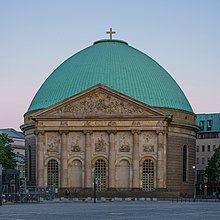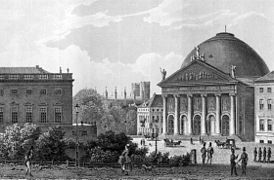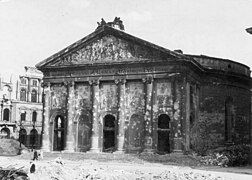St. Hedwig's Cathedral
| St. Hedwig's Cathedral | |
|---|---|
 St. Hedwig's Cathedral in 2018 | |
| Religion | |
| Affiliation | Roman Catholic |
| Province | Archdiocese of Berlin |
| Ecclesiastical or organizational status | Built and Renovated |
| Year consecrated | 1773 |
| Location | |
| Location | Mitte, Berlin, Germany |
| Architecture | |
| Architect(s) | Georg Wenzeslaus von Knobelsdorff (original) Hans Schwippert (reconstruction) |
| Style | Baroque (original) post-war modernism (reconstruction) |
| Completed | 1887 (original) 1963 (reconstruction) 2024 Renovation |
| Specifications | |
| Direction of façade | north-west |
| Height (max) | 77 m, 2 m high cross |
| Dome(s) | 2 |
| Dome height (outer) | 71 m, roof |
| Spire(s) | 2 |
| Spire height | 75 m, [1] middle cross |
| Materials | Stones, Copper, Stucco |
| Website | |
| www.hedwigs-kathedrale.de | |
St. Hedwig's Cathedral (German: St.-Hedwigs-Kathedrale) is the Catholic cathedral of the Archdiocese of Berlin on Bebelplatz in the historic centre of Berlin. Dedicated to Hedwig of Silesia, it was erected from 1747 to 1773 by order of Frederick the Great according to plans by Georg Wenzeslaus von Knobelsdorff in Baroque style. Damaged during the Allied bombing in World War II, the cathedral's interior was restored from 1952 to 1963 in post-war modernist style as part of the rebuilding of the Forum Fridericianum on Bebelplatz. The listed building was closed for renovation work from 2018 and reopened on November 24, 2024 with a modern interior design.[2][3][4]
History and architecture
[edit]St. Hedwig's Church was built in the 18th century following a request from local parishioners to King Frederick II. He donated the land on which the church was built. The church was dedicated to the patron of Silesia and Brandenburg, Saint Hedwig of Andechs. It was the first Catholic church built in Prussia after the Reformation. The building was designed by Georg Wenzeslaus von Knobelsdorff and modelled after the Pantheon in Rome.[5]
Construction started in 1747, but was interrupted and delayed several times by economic problems. It was not opened until 1 November 1773, when the king's friend, Ignacy Krasicki, the Bishop of Warmia (later Archbishop of Gniezno), officiated at the cathedral's consecration.[5]
After the Kristallnacht pogroms that took place on the night of 9–10 November 1938, Bernhard Lichtenberg, a canon of the cathedral chapter of St. Hedwig since 1931, prayed publicly for Jews at evening prayer. Lichtenberg was later jailed by the Nazis and died on the way to the concentration camp at Dachau.[6] In 1965, Blessed Bernhard Lichtenberg's remains were transferred to the crypt at St. Hedwig's Cathedral.
The cathedral was severely damaged by Allied bombing in an air raid on 1 March 1943. Only the damaged shell of the building was left standing. Reconstruction started in 1952 and on 1 November 1963, All Saints' Day, the new high altar was consecrated by the Bishop of Berlin, Alfred Cardinal Bengsch.[7]
Between 1949 and 1990, St. Hedwig's was in East Berlin, under the control of the East German government.
The cathedral closed for major renovations on 1 September 2018. The relics of Bl. Bernhard Lichtenberg have been transferred to the crypt of Maria Regina Martyrum during the cathedral's renovation.[5] The church of St. Joseph in Wedding is the interim location for pontifical masses. A focal point of the renovations is a hemispherical altar composed of small stones from around the diocese collected by parishioners, based on an idea proposed by Austrian artist Leo Zogmayer.[2] The two-story interior of 1963, with a wide gallery and an awkwardly narrow opening down to the chancel, was divided into two floors, with the new church interior on the upper level.
Tapestries
[edit]Fitting to the character of the liturgical season, a huge tapestry is hanging behind the cathedra. The cathedral owns three of them; all three share the motif of the heavenly Jerusalem.[8]
The tapestry of former Bauhaus student Margaretha Reichardt (Grete Reichardt) (1907–1984) of Erfurt was handwoven in 1963. It depicts a stylised city with the names of the apostles inscribed on foundation stones. God is represented by the Tree of Life and a lamb features as a symbol of Christ. Anton Wendling (1891–1965) made a colorful appliqué work. It is a geometric composition using themes from the Book of Revelation. The three-part woven carpet made by Else Bechteler-Moses (born 1933) was made in cooperation with Nürnberger Gobelinmanufaktur GmbH, a tapestry weaving company, between 1979 and 1981. This also uses themes from Revelations.
Burials in the crypt
[edit]Gallery
[edit]- Historical images
-
Plan of Jean Laurent Legeay with Drawing of Georg Wenzeslaus von Knobelsdorff in 1747, the top dome was never rebuilt
-
Opernplatz with undone church before 1886
-
Drawing of the cathedral by Joseph Maximilian Kolb, 1850
-
Cathedral in 1886
-
Cathedral after 1886
-
Interior by 1780
-
Interior before air raids of 1943
-
Ruins of the cathedral after WWII in 1946
- Interior of 1963
-
Interior in 2016 with opening in the floor
-
Interior in June 2014
-
Altar Column
-
Organ in the lower church
-
Tomb of Bernhard Lichtenberg in crypt
- Redesigned interior of 2024
See also
[edit]References
[edit]- ^ https://ootel.com/en/discovering-the-architectural-marvel-the-glorious-st-hedwigs-cathedral/
- ^ a b Vosshenrich, Ursula; Gräf, Carmen (November 1, 2023). "Das neue Herzstück von St. Hedwig" (in German). rbb24. Retrieved January 20, 2024.
- ^ "Wiedereröffnung der Sankt Hedwigs-Kathedrale - Ab 24. November 2024 wieder offen mit Sonderprogramm" (in German). Retrieved November 17, 2024.
- ^ "Alles neu in Sankt Hedwig" (in German). November 20, 2024. Retrieved November 24, 2024.
- ^ a b c "History of St. Hedwig's Cathedral". St.Hedwigs Kathedrale Berlin (in German). Retrieved 28 April 2023.
- ^ "Bernhard Lichtenberg - the righteous among the nations". Yad Vashem. Retrieved 28 April 2023.
- ^ "Destruction and reconstruction". St. Hedwigs Kathedrale Berlin. Archived from the original on 14 April 2018. Retrieved 19 October 2016.
- ^ "Interior". St.Hedwigs Kathedrale Berlin. Archived from the original on 18 August 2016. Retrieved 19 October 2016.
External links
[edit]- Website of the cathedral Archived 2022-12-07 at the Wayback Machine, includes mass schedule
- Roman Catholic cathedrals in Germany
- Basilica churches in Germany
- Roman Catholic churches in Berlin
- Buildings and structures in Mitte
- Tapestries
- 18th-century Roman Catholic church buildings in Germany
- Buildings and structures in Berlin destroyed during World War II
- Rebuilt buildings and structures in Berlin
- Roman Catholic churches completed in 1773
- Roman Catholic churches completed in 1963
- Minor basilicas in Germany
- Rebuilt churches in Germany















